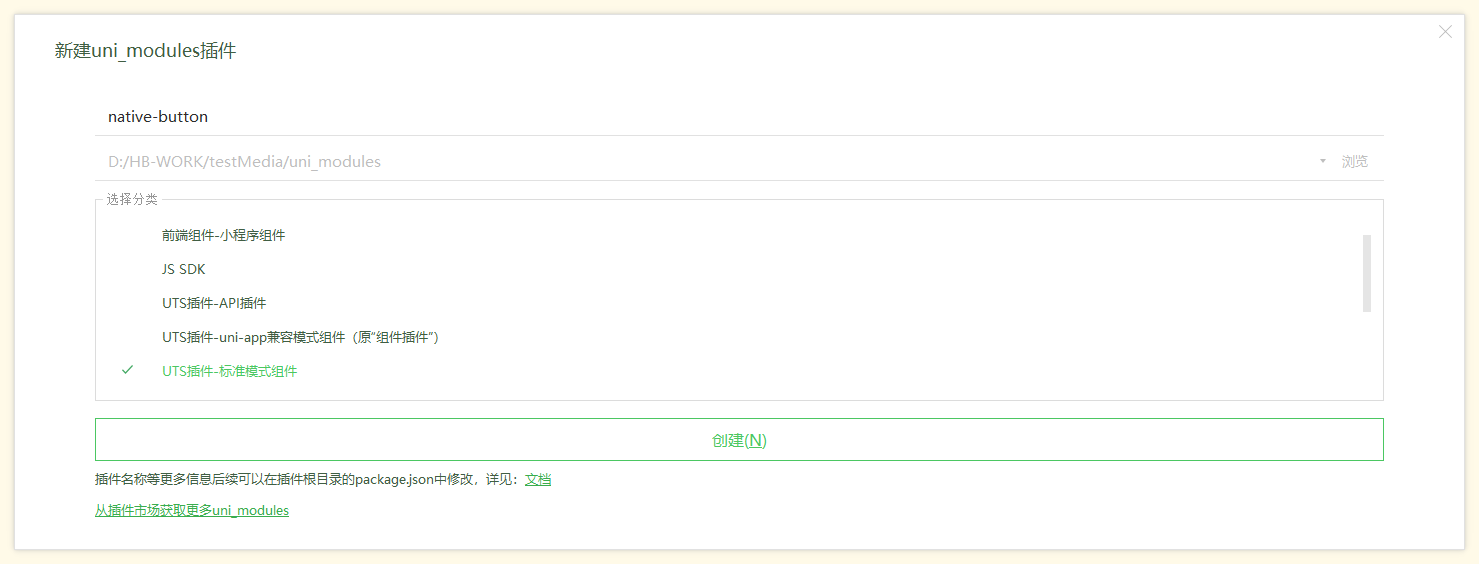
简体中文
使用vue组件开发规范,通过插件封装原生平台view提供给native-view组件,实现组件特定功能及UI展示。
继续阅读文档前,开发者需要了解以下前置条件:
┌─components // vue组件代码
| ├─xxx // vue组件名称文件夹 xxx代替组件名称
| ├─xxx.uvue // vue组件uts代码 xxx代替组件名称
├─static // 静态资源
├─utssdk
│ ├─app-android //Android平台目录
│ │ ├─assets //Android原生assets资源目录,可选
│ │ ├─libs //Android原生库目录,可选
│ │ ├─res //Android原生res资源目录,可选
│ │ ├─AndroidManifest.xml //Android原生应用清单文件,可选
│ │ ├─config.json //Android原生配置文件
│ │ ├─index.uts //Android原生插件能力实现,可选
│ ├─app-ios //iOS平台目录
│ │ ├─Frameworks //iOS原生依赖的第三方 framework 依赖库存放目录,可选
│ │ ├─Resources //iOS原生所依赖的资源文件存放目录,可选
│ │ ├─info.plist //iOS原生所需要添加到主 info.plist 文件中的配置文件,可选
│ │ ├─UTS.entitlements //iOS原生所需要添加到主工程 .entitlements 文件中的配置文件,可选
│ │ ├─config.json //iOS原生配置文件
│ │ ├─index.uts //iOS原生插件能力实现,可选
│ ├─web //web平台目录
│ │ └─index.uts
│ └─index.uts // 跨平台插件能力实现,可选
└─package.json // 插件清单文件
如上所示,UTS插件-标准模式组件目录结构与UTS插件基本相同,差别在于components目录,vue组件代码存放components目录下。
其他目录文件详情可参考UTS插件文档
HBuilder X 选中你的项目,项目根目录选中uni_modules目录,右键选择新建uni_modules插件,弹窗后分类选择 “UTS插件-标准模式组件”,填写组件名称,以下均已 native-button 为例

创建完毕 HBuilder X 会自动构建模版文件,参考: UTS插件-标准模式组件目录结构
构建标准模式组件后,HBuilder X 会自动创建components/native-button/native-button.uvue文件,在该文件编写代码添加 native-view 标签
<template>
<native-view></native-view>
</template>
native-view 初始化会触发 @init 事件,此时创建NativeButton对象,native-button.uvue代码中用NativeButton对象调用插件相关的API。将 UniNativeViewElement 传递给NativeButton对象,进行关联绑定
NativeButton是在utssdk目录构建的原生对象。NativeButton对象内部处理原生view与native-view绑定关联业务
组合式 API
选项式 API
<template>
<native-view @init="onviewinit"></native-view>
</template>
<script setup lang="uts">
//引入 NativeButton 原生对象
import { NativeButton } from "@/uni_modules/native-button";
let button : NativeButton | null = null
//native-view初始化时触发此方法
function onviewinit(e : UniNativeViewInitEvent) {
//获取UniNativeViewElement 传递给NativeButton对象
button = new NativeButton(e.detail.element);
}
</script>
在 methods 节点中添加updateText方法,native-button组件使用者可调用该方法更新native-button文案。 页面调用组件方法
组合式 API
选项式 API
<script setup lang="uts">
//引入 NativeButton 原生对象
import { NativeButton } from "@/uni_modules/native-button";
let button : NativeButton | null = null
//声明方法
function updateText(value : string) {
button?.updateText(value)
}
</script>
native-button 声明props,例如native-button的文案信息text属性,按vue组件规范监听到text属性更新,通过NativeButton对象驱动更新原生view属性,在components/native-button/native-button.uvue编写如下代码,具体参考vue组件Props规范
组合式 API
选项式 API
<script setup lang="uts">
//声明属性
const props = defineProps<{ text : string }>()
//声明方法
function updateText(value : string) {
button?.updateText(value)
}
//监听属性变化
watchEffect(() => {
// console.log("watchEffect "+props.text)
const text = props.text
updateText(text)
})
</script>
native-button 声明事件,例如原生组件触发点击事件@buttonTap, NativeButton对象通过 UniNativeViewElement 的 dispatchEvent 函数触发native-view的 @customClick 自定义事件。native-button.uvue监听native-view的 @customClick 自定义事件实现emit触发声明事件,具体参考vue组件事件规范
组合式 API
选项式 API
<template>
<native-view @customClick="ontap"></native-view>
</template>
<script setup lang="uts">
//声明事件
const emit = defineEmits<{
(e : "buttonTap", event : UniNativeViewEvent) : void
}>()
function ontap(e : UniNativeViewEvent) {
emit("buttonTap", e)
}
</script>
注意:
目前自定义事件参数仅支持UniNativeViewEvent
native-button/components/native-button/native-button.uvue 最终代码如下:
组合式 API
选项式 API
<template>
<native-view @init="onviewinit" @customClick="ontap"></native-view>
</template>
<script setup lang="uts">
import { NativeButton } from "@/uni_modules/native-button";
let button : NativeButton | null = null
//声明属性
const props = defineProps<{ text : string }>()
//声明事件
const emit = defineEmits<{
(e : "buttonTap", event : UniNativeViewEvent) : void
}>()
//声明方法
function updateText(value : string) {
button?.updateText(value)
}
//监听属性变化
watchEffect(() => {
const text = props.text
updateText(text)
})
//native-view初始化时触发此方法
function onviewinit(e : UniNativeViewInitEvent) {
//获取UniNativeViewElement 传递给NativeButton对象
button = new NativeButton(e.detail.element);
updateText(props.text)
}
function ontap(e : UniNativeViewEvent) {
emit("buttonTap", e)
}
function onUnmounted() {
// iOS平台需要主动释放 uts 实例
button?.destroy()
}
</script>
utssdk目录实现不同平台的原生NativeButton对象,构造参数获取UniNativeViewElement对象与原生view绑定,封装原生view功能关联的API。
Android
iOS
import { Button } from "android.widget"
export class NativeButton {
$element : UniNativeViewElement;
constructor(element : UniNativeViewElement) {
//接收传递过来的UniNativeViewElement
this.$element = element;
this.bindView();
}
button : Button | null = null;
bindView() {
//通过UniElement.getAndroidActivity()获取android平台activity 用于创建view的上下文
this.button = new Button(this.$element.getAndroidActivity()!); //构建原生view
//限制原生Button 文案描述不自动大写
this.button?.setAllCaps(false)
//监听原生Button点击事件
this.button?.setOnClickListener(_ => {
const detail = {}
//构建自定义UniNativeViewEvent返回对象
const event = new UniNativeViewEvent("customClick", detail)
//触发原生Button的点击事件
this.$element.dispatchEvent(event)
})
//UniNativeViewEvent 绑定 安卓原生view
this.$element.bindAndroidView(this.button!);
}
updateText(text: string) {
//更新原生Button 文案描述
this.button?.setText(text)
}
destroy(){
//数据回收
}
}
更多实现可参考 标准模式组件 native-button
此时一个简单的UTS插件-标准模式组件就完成了,
注意:
以 native-button 为例, 创建标准模式组件的项目页面可以直接使用 native-button 标签,也可将native-button插件包放置其他项目的uni-modules文件夹中。项目页面即可使用 native-button 标签
<template>
<view style="flex:1">
<native-button class="native-button" text="buttonText" @buttonTap="ontap"></native-button>
</view>
</template>
<script>
export default {
methods: {
ontap(e : UniNativeViewEvent) {
console.log("ontap----------"+e.type)
}
}
}
</script>
<style>
.native-button {
height: 100px;
width: 200px;
margin: 25px auto 25px auto;
}
</style>